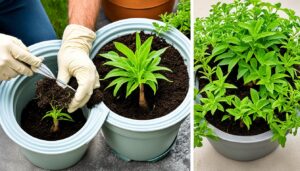Introduction:
In the realm of indoor gardening, few plants embody serenity and elegance quite like the peace lily (Spathiphyllum). With its lush, glossy foliage and delicate, white blooms, this resilient botanical not only graces our homes and offices with its beauty but also serves as a symbol of peace and harmony. Beyond its ornamental value, the peace lily holds another allure: its ease of propagation. Whether you’re a novice gardener or a seasoned enthusiast, propagating peace lilies can be a rewarding and straightforward endeavor.
Propagation, the art of multiplying plants from existing specimens, allows enthusiasts to expand their greenery without the need for purchasing new plants. For peace lily aficionados, propagating these beloved botanicals offers a chance to share their beauty with friends and family, as well as to cultivate a deeper connection with nature through hands-on gardening.
In this comprehensive guide, we will delve into the various methods of propagating peace lilies, from division to leaf cuttings, providing practical tips and insights to help you nurture new growth and foster a sense of tranquility in your indoor oasis. Whether you’re seeking to expand your collection of peace lilies or simply wish to explore the art of propagation, join us on this journey as we unlock the secrets to cultivating serenity through the propagation of peace lilies.
Understanding Propagation Methods
Before delving into the specifics of propagating peace lilies, it’s essential to understand the various methods available. Each propagation technique offers its own set of advantages and considerations, catering to different preferences and circumstances. Below, we outline three primary methods for propagating peace lilies:
- Division: Division is perhaps the most common and straightforward method of propagating peace lilies. This technique involves separating an established plant into smaller sections, each with its own roots and foliage. Division is ideally suited for mature peace lilies that have outgrown their pots or exhibit multiple crowns.
Procedure:
- Carefully remove the peace lily from its pot, taking care not to damage the roots.
- Gently tease apart the root ball to separate individual sections, ensuring that each division has at least one healthy stem and an adequate root system.
- Plant each division in its own pot filled with well-draining potting mix, ensuring that the crown (the point where the stems emerge from the roots) remains at soil level.
- Water the newly potted divisions thoroughly and place them in a location with indirect light.
Advantages:
- Fast and reliable method.
- Divisions typically establish quickly and resume growth without significant setback.
- Allows for the rejuvenation of overcrowded or leggy plants.
Considerations:
- Best performed during the plant’s active growth phase (spring or early summer).
- Ensure each division has a sufficient root system to support its growth.
- Leaf Cuttings: Leaf cuttings offer an alternative method of propagating peace lilies, particularly suitable for individuals who prefer a less invasive approach. This technique involves rooting individual leaves to produce new plants, offering the opportunity to multiply your peace lily collection with minimal disruption to the parent plant.
Procedure:
- Select a healthy, mature leaf from the parent plant, ensuring it has a visible petiole (leaf stalk).
- Using a clean, sharp knife or scissors, carefully cut the leaf at its base, ensuring a clean cut.
- Place the leaf cutting in a container filled with water, ensuring that the petiole is submerged while the leaf remains above the waterline.
- Position the container in a warm, bright location with indirect sunlight, replenishing the water as needed to maintain hydration.
Advantages:
- Allows for the propagation of multiple plants from a single leaf.
- Minimal disruption to the parent plant.
- Suitable for individuals with limited space or resources.
Considerations:
- Leaf cuttings may take longer to root and establish compared to other methods.
- Monitor the cutting for signs of rot or decay, and discard any affected specimens promptly.
Providing Optimal Growing Conditions
Successful propagation of peace lilies relies not only on choosing the right method but also on providing optimal growing conditions to support the development of healthy, robust plants. From lighting and temperature to soil and watering, each aspect plays a crucial role in nurturing new growth. Below, we outline key considerations for creating an ideal environment for propagated peace lilies:
- Lighting:
- Peace lilies thrive in bright, indirect light, making them well-suited for indoor environments with filtered sunlight or artificial lighting.
- Avoid exposing newly propagated plants to direct sunlight, as this can scorch their delicate foliage and impede growth.
- Place peace lilies near north- or east-facing windows to provide gentle, indirect light throughout the day.
- Temperature:
- Maintain a consistent temperature range of 65-80°F (18-27°C) for optimal growth and development.
- Avoid exposing peace lilies to drafts or sudden fluctuations in temperature, as this can stress the plants and hinder their progress.
- Consider placing the propagated plants in a location with stable temperatures, away from heating vents or air conditioning units.
- Soil:
- Use a well-draining potting mix rich in organic matter, such as a blend of peat moss, perlite, and compost.
- Ensure the soil retains moisture without becoming waterlogged, as excessive moisture can lead to root rot and other fungal diseases.
- Consider adding a layer of mulch or sphagnum moss to the soil surface to help retain moisture and regulate temperature.
- Watering:
- Water propagated peace lilies thoroughly, allowing excess water to drain freely from the bottom of the pot.
- Avoid overwatering, as soggy soil can suffocate the roots and promote fungal growth.
- Allow the top inch (2.5 cm) of soil to dry out between waterings, adjusting the frequency based on environmental conditions and plant needs.
- Humidity:
- Peace lilies thrive in moderate to high humidity levels, making them ideal candidates for bathrooms or kitchens with naturally humid conditions.
- Increase humidity levels by placing a tray filled with water and pebbles beneath the plants or by using a humidifier.
- Mist the foliage occasionally to provide additional moisture and prevent dehydration.
Monitoring and Troubleshooting
While propagating peace lilies can be a rewarding experience, it’s essential to monitor the progress of your plants and address any issues that may arise promptly. From pest infestations to nutrient deficiencies, various factors can impact the health and vitality of propagated peace lilies. In this section, we explore common challenges encountered during propagation and provide guidance on how to identify and resolve them effectively:
- Pest Infestations:
- Common Pests: Keep an eye out for common pests such as aphids, spider mites, and mealybugs, which can infest peace lilies and hinder their growth.
- Identification: Inspect the foliage and stems for signs of pest activity, including tiny insects, webbing, or sticky residue.
- Treatment: Treat affected plants promptly with organic insecticidal soap or neem oil, ensuring thorough coverage of both the upper and lower leaf surfaces. Repeat the treatment as needed until the pests are eradicated.
Common Pests | Signs of Infestation | Treatment |
Aphids | Clusters of tiny insects on new growth | Insecticidal soap or neem oil |
Spider Mites | Fine webbing on leaves, yellow stippling | Rinse with water, apply insecticidal soap |
Mealybugs | Cottony white masses on stems and leaves | Remove by hand, apply rubbing alcohol |
- Nutrient Deficiencies:
- Symptoms: Pay attention to signs of nutrient deficiencies, such as yellowing or browning leaves, stunted growth, or leaf discoloration.
- Diagnosis: Conduct a soil test to determine the nutrient levels in the growing medium and identify any deficiencies.
- Correction: Adjust the fertilization regimen as needed, choosing a balanced liquid fertilizer formulated for houseplants. Apply the fertilizer according to the manufacturer’s instructions, taking care not to over-fertilize.
Nutrient Deficiency | Symptoms | Correction |
Nitrogen | Yellowing of older leaves | Apply balanced fertilizer |
Phosphorus | Stunted growth, dark green foliage | Use phosphorus-rich fertilizer |
Potassium | Leaf tip burn, weak stems | Apply potassium-rich fertilizer |
- Disease Management:
- Common Diseases: Watch for signs of fungal diseases such as root rot, powdery mildew, and leaf spot, which can occur due to overwatering or poor air circulation.
- Prevention: Ensure proper drainage and ventilation to reduce the risk of fungal infections. Avoid overhead watering, as wet foliage can promote disease development.
- Treatment: If disease symptoms appear, remove affected plant parts promptly and improve growing conditions to discourage further spread. Consider applying a fungicide labeled for houseplants to control fungal growth.
Common Diseases | Symptoms | Prevention and Treatment |
Root Rot | Wilting, yellowing leaves | Improve drainage, reduce watering |
Powdery Mildew | White powdery patches on leaves | Increase air circulation, apply fungicide |
Leaf Spot | Brown or black spots on leaves | Remove affected leaves, apply fungicide |
Patience and Persistence: Tips for Success
Successfully propagating peace lilies requires not only knowledge of the techniques involved but also a patient and persistent approach. While the process may seem straightforward, it’s essential to recognize that propagation can be a journey filled with challenges and rewards. In this section, we offer practical tips to help you navigate the propagation process with confidence and achieve success:
- Start with Healthy Parent Plants:
- Begin the propagation process with healthy, vigorous parent plants. Healthy parent plants are more likely to produce viable offspring with strong growth potential.
- Inspect the parent plants regularly for signs of pests, diseases, or nutrient deficiencies, and address any issues promptly to ensure optimal conditions for propagation.
- Be Mindful of Timing:
- Choose the appropriate time for propagation based on the plant’s growth cycle. For division, spring or early summer is often the best time, as plants are actively growing and more resilient to transplantation.
- For leaf cuttings, select mature leaves with healthy petioles during the plant’s active growth phase. Avoid taking cuttings from stressed or weakened plants, as they may struggle to root successfully.
- Provide Adequate Care and Attention:
- Maintain consistent growing conditions, including proper lighting, temperature, soil moisture, and humidity, to support the growth of propagated plants.
- Monitor the progress of newly propagated plants closely, checking for signs of growth, root development, and overall health. Adjust care practices as needed to address any issues that arise.
- Practice Patience:
- Understand that propagation takes time, and results may not be immediate. Be patient and allow the plants sufficient time to establish themselves and develop a strong root system.
- Avoid rushing the process or attempting to force growth through excessive fertilization or environmental manipulation. Instead, trust in the natural growth process and provide consistent care and nurturing.
- Celebrate Successes and Learn from Challenges:
- Celebrate each milestone in the propagation journey, whether it’s the emergence of new growth, the development of healthy roots, or the successful transition to a larger pot.
- View challenges as opportunities for learning and growth. If a propagation attempt is unsuccessful, take the time to reflect on what went wrong and identify areas for improvement in future attempts.
As you are developing your appreciation of the Peace Lily I think you may enjoy our article Embracing The Peace Lily.
Conclusion: Cultivating Tranquility through Propagation
In the realm of indoor gardening, few pursuits offer the same sense of fulfillment and satisfaction as propagating peace lilies. From the initial division of a mature plant to the delicate process of rooting leaf cuttings, each step in the propagation journey represents a commitment to nurturing new life and fostering a deeper connection with nature. As we conclude our exploration of propagating peace lilies, it’s evident that this endeavor extends far beyond the mere multiplication of plants; it embodies a quest for tranquility and harmony in our indoor spaces.
Through patience, persistence, and a mindful approach to care, gardeners can unlock the secrets of successful propagation and reap the rewards of their efforts. Whether it’s the joy of watching new shoots emerge from the soil or the satisfaction of sharing the beauty of peace lilies with friends and family, each propagation success is a testament to the transformative power of gardening.
As we tend to our propagated peace lilies, let us not only nurture their physical growth but also cultivate a sense of peace and serenity within ourselves. May the presence of these graceful botanicals serve as a reminder to pause, breathe, and appreciate the beauty that surrounds us, both in our gardens and in our lives.
In the quiet elegance of a thriving peace lily, we find not only a reflection of nature’s resilience but also a beacon of hope and tranquility in an increasingly busy world. Let us continue to propagate peace lilies, not only for their beauty but also for the sense of calm and contentment they bring into our homes and hearts.
Thanks for visiting us here at The TrustedHouseplant Guide. If you happen to be nearby stop inat The Landscape Connection and see us.





Pingback: Peace Lily Care in Cool Conditions: How to Keep This Air-Purifying Plant Thriving
Pingback: Peace Lily, The Elegant, Beginner-Friendly Houseplant That Blooms Indoors